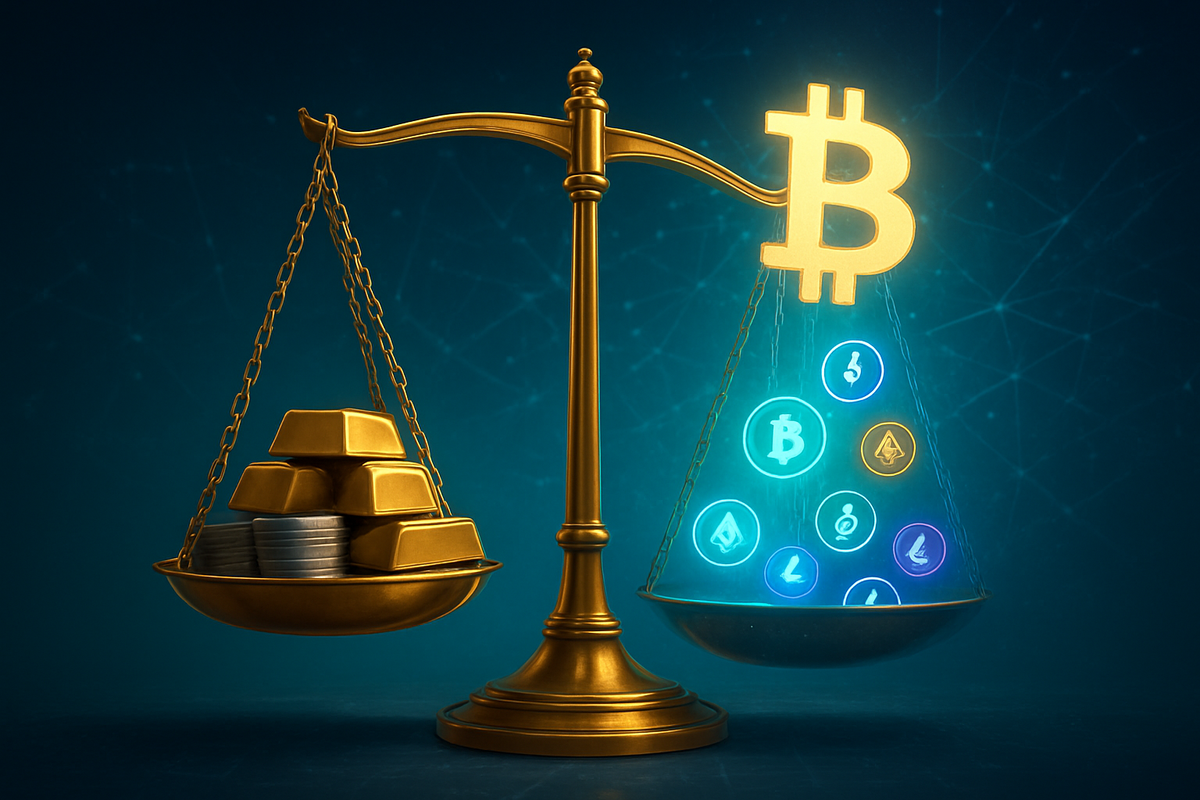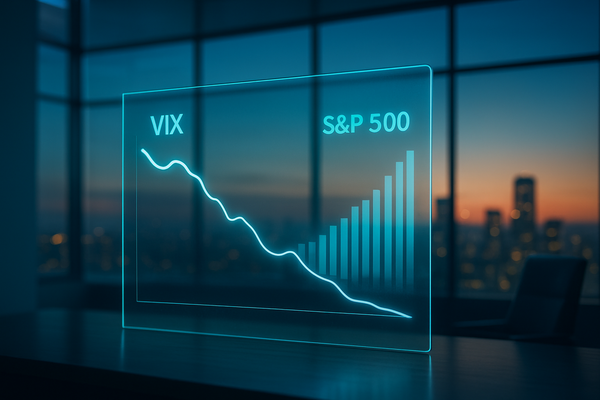The Great Rotation: Investors Flee Gold and Silver for Bitcoin, Igniting Altcoin Season Speculation

October 26, 2025 – A seismic shift is underway in global financial markets as investors are rapidly reallocating capital, abandoning traditional safe-haven assets like gold and silver in favor of the surging digital titan, Bitcoin (BTC-X). This significant rotation has sent shockwaves through both the precious metals and cryptocurrency sectors, with gold and silver prices experiencing precipitous declines while Bitcoin has remarkably soared past the $112,000 mark. The dramatic movement is not merely a transfer of wealth but is increasingly viewed as the potential catalyst for an eagerly anticipated "altcoin season," promising a new wave of opportunity and volatility across the broader cryptocurrency landscape.
This unprecedented migration of investor funds signals a profound change in market sentiment, moving away from cautious preservation towards a bolder embrace of digital assets as a hedge against inflation and a store of value. The immediate implications are stark: a period of significant correction and diminished confidence for precious metals, and a potentially explosive growth phase for altcoins following Bitcoin's lead. As the financial world watches, this "great rotation" could redefine investment strategies for years to come, challenging long-held beliefs about safe havens and ushering in a new era dominated by digital finance.
The Digital Gold Rush: Unpacking the Market's Pivotal Shift
The current financial narrative is dominated by the dramatic outflow from precious metals and the corresponding influx into Bitcoin. Mid-October 2025 witnessed a stark illustration of this trend, with gold experiencing its steepest single-day drop since 2013, plummeting approximately 6%. Silver (XAG-X) fared even worse, plunging around 9% in what marked its sharpest fall since 2021. These declines were not isolated incidents but occurred concurrently with Bitcoin's (BTC-X) robust ascent, pushing its value significantly higher. Bitcoin briefly touched an all-time high of approximately $125,264 on October 5, 2025, before a minor pullback, only to regain momentum and decisively breach the $112,000 threshold by October 26, 2025, approaching $113,000. Earlier in the week, specifically around October 24-25, Bitcoin climbed to levels between $111,500 and $112,000, bolstered by a positive 3% inflation report and increased odds of an interest rate cut by the Federal Reserve.
This "great rotation" is driven by a confluence of factors. Analysts point to significant profit-taking in gold and silver after prolonged rallies, combined with a decreasing demand for traditional safe-haven assets. This reduced demand is partly attributed to an improved geopolitical landscape, notably optimism surrounding U.S.-China trade negotiations. Simultaneously, growing expectations of interest rate cuts by the Federal Reserve are making non-yielding assets like gold less attractive, while risk assets, including Bitcoin, become more appealing. Bitcoin is increasingly being perceived as a modern hedge against inflation and monetary uncertainty, solidifying its role as "digital gold" in investor portfolios. Some analyses suggest that even a minor reallocation of 3-4% of capital from the gold market could lead to a substantial increase in Bitcoin's price due to the vast difference in market capitalization.
The bullish trajectory for Bitcoin is further fueled by growing institutional adoption. A steady influx of institutional investors, including major corporations and hedge funds, are allocating significant capital to Bitcoin, providing substantial buying pressure and enhancing its legitimacy. Bitcoin Exchange-Taded Funds (ETFs), in particular, have seen renewed inflows, with US Bitcoin ETFs recording net inflows of $20 million in recent trading sessions, signaling a revival of institutional interest. Macroeconomic factors, such as persistent inflation concerns and the global search for alternative stores of value, continue to steer investors towards scarce assets like Bitcoin. Softer inflation data and the anticipation of Federal Reserve rate cuts are widely interpreted as bullish signals for risk assets, including Bitcoin. Furthermore, Bitcoin's fixed supply and periodic halving events create a scarcity effect, which, combined with rising demand and continuous technological advancements within its ecosystem, further fuels upward price movements and investor confidence.
Winners and Losers in the Digital Exodus
The profound shift in investor preference from precious metals to Bitcoin creates clear winners and losers across various industries and companies. On the winning side, cryptocurrency exchanges like Coinbase Global (NASDAQ: COIN), Binance (BNB-X), and Kraken stand to benefit immensely from increased trading volumes, transaction fees, and new user registrations. As more capital flows into Bitcoin and potentially altcoins, these platforms become central hubs for activity, directly boosting their revenue streams. Similarly, Bitcoin mining companies such as Marathon Digital Holdings (NASDAQ: MARA) and Riot Platforms (NASDAQ: RIOT) will see their profitability soar. The higher Bitcoin price directly translates to more valuable mining rewards, incentivizing further investment in mining infrastructure and potentially leading to expansion.
Companies with significant Bitcoin holdings on their balance sheets, like MicroStrategy (NASDAQ: MSTR), are experiencing substantial increases in their asset valuations, which can positively impact their stock prices and overall financial health. Furthermore, blockchain technology providers and developers of decentralized finance (DeFi) protocols are poised for growth. As the crypto market expands, so does the demand for underlying technologies and innovative applications built on blockchain, attracting more talent and capital to the sector. This includes companies involved in crypto infrastructure, security, and wallet services.
Conversely, gold and silver mining companies are facing significant headwinds. Companies like Barrick Gold (NYSE: GOLD), Newmont (NYSE: NEM), and Wheaton Precious Metals (NYSE: WPM) are likely to see their revenues and profits decline as the prices of the commodities they extract fall. This could lead to reduced exploration budgets, potential project delays, and decreased shareholder returns. Precious metals dealers and refiners will also experience a slowdown in demand for physical gold and silver, impacting their sales volumes and margins. Furthermore, investment funds heavily weighted in precious metals, particularly those without exposure to digital assets, will suffer underperforming portfolios, potentially leading to investor outflows and pressure to diversify.
The traditional financial institutions that have been slow to embrace digital assets may also find themselves at a disadvantage, struggling to attract and retain clients who are increasingly looking for exposure to the burgeoning crypto market. This shift underscores the growing importance for financial players across the board to adapt to the evolving investment landscape or risk being left behind.
Broader Implications and Historical Parallels
This investor rotation out of precious metals and into Bitcoin represents more than just a market trend; it signifies a fundamental shift in how investors perceive and utilize assets for wealth preservation and growth. This event fits into the broader industry trend of the digitization of finance and the increasing mainstream acceptance of cryptocurrencies. Bitcoin's ascent past $112,000, particularly its role as a "digital gold," challenges the long-held dominance of physical commodities as the ultimate safe haven. This trend suggests a maturation of the crypto market, where digital assets are no longer niche speculative plays but are becoming integral components of diversified investment portfolios, especially among institutional players.
The ripple effects on competitors and partners are substantial. For traditional financial services, the pressure to offer crypto-related products and services will intensify. Banks and asset managers who have been hesitant to fully embrace digital assets may find themselves losing market share to more agile fintech companies and crypto-native platforms. Partnerships between traditional finance and crypto firms are likely to accelerate, aiming to bridge the gap between old and new financial systems. Regulatory bodies worldwide are also keenly observing this shift. The increased institutional involvement and the scale of capital movement will undoubtedly prompt further scrutiny and potentially lead to new regulatory frameworks. Discussions around consumer protection, market manipulation, and the integration of digital assets into existing financial laws will become even more critical.
Historically, periods of significant technological advancement or shifts in global economic paradigms have led to revaluations of asset classes. One could draw parallels to the dot-com bubble of the late 1990s, where traditional industries were temporarily overshadowed by the promise of internet companies, or the rise of fiat currency over commodity-backed money. While the specifics differ, the underlying theme of new technologies challenging established norms remains. The current scenario highlights Bitcoin's growing status as a legitimate alternative to gold, especially for a younger generation of investors who are more comfortable with digital native assets. This shift also reflects a growing distrust in traditional financial systems and government-issued currencies, pushing investors towards decentralized alternatives.
The Road Ahead: Navigating a New Financial Frontier
Looking ahead, the short-term possibilities for the cryptocurrency market, particularly for altcoins, are highly dynamic. With Bitcoin having established a strong foundation above $112,000, many analysts anticipate that its market dominance may soon begin to recede, paving the way for a robust "altcoin season." This period, where alternative cryptocurrencies experience significant gains, could see a massive liquidity shift towards altcoins later in the year, potentially triggering a "parabolic pump" across the market. The total altcoin market capitalization is showing a strong technical setup, potentially breaking above a significant 3-year resistance level near $1.46 trillion. However, caution remains, as some altcoin season indicators currently sit at bear market lows, suggesting that while the potential for a liquidity shift is high, a full-blown altcoin season is not yet unequivocally confirmed. October 2025 is seen as a critical "setup month," with the altcoin season potentially extending into early 2026.
In the long term, this rotation underscores Bitcoin's growing role as a global macro asset and a primary store of value in the digital age. The increasing institutional adoption, coupled with favorable macroeconomic conditions such as potential interest rate cuts by the Federal Reserve, suggests sustained interest and investment in the crypto space. Strategic pivots will be essential for both traditional financial institutions and precious metals companies. Precious metals firms may need to explore diversification into other commodities or even consider adopting blockchain technologies for supply chain management or tokenization of assets to remain relevant. Financial advisors will need to integrate digital assets into their clients' portfolios, offering guidance on risk management and asset allocation in this evolving landscape.
Market opportunities will emerge for innovative projects within the DeFi (decentralized finance) and NFT (non-fungible token) sectors, as well as for layer-2 solutions that enhance scalability and reduce transaction costs for major blockchains. Challenges include navigating evolving regulatory environments, managing market volatility, and addressing concerns around cybersecurity. Potential scenarios range from a sustained bull run across the entire crypto market, fueled by continued institutional inflows and widespread adoption, to periods of significant correction as the market digests rapid gains. The approval of over 150 altcoin Exchange-Traded Funds (ETFs) currently awaiting SEC approval could provide a substantial catalyst for altcoin growth, dramatically expanding access for mainstream investors.
A New Dawn for Digital Assets: A Comprehensive Wrap-up
The ongoing investor rotation from gold and silver into Bitcoin marks a pivotal moment in financial history, signaling a paradigm shift in how value is perceived and stored. The key takeaway is the undeniable ascendancy of digital assets, with Bitcoin solidifying its position as "digital gold" and a viable alternative, if not a superior one, to traditional precious metals in an increasingly digitized world. The dramatic price movements, including gold's steepest single-day drop since 2013 and Bitcoin's surge past $112,000, underscore the magnitude of this re-evaluation. This trend is not merely a fleeting market anomaly but reflects deeper macroeconomic forces, technological advancements, and evolving investor sentiment.
Moving forward, the market is poised for continued volatility but with a clear bullish bias for digital assets. The anticipation of an "altcoin season" following Bitcoin's dominance is a significant indicator of potential widespread growth across the broader cryptocurrency ecosystem. This means that while Bitcoin may lead the charge, a surge in liquidity and investor interest could flow into other promising altcoins, offering substantial opportunities for those positioned correctly. The shift also highlights the increasing irrelevance of traditional safe havens for a segment of the investment community, particularly as geopolitical tensions ease and central banks signal more accommodating monetary policies.
The lasting impact of this event will likely be the permanent integration of digital assets into mainstream investment portfolios and financial strategies. It will accelerate the adoption of blockchain technology across various industries and push regulatory bodies to develop more comprehensive frameworks for digital finance. Investors should closely watch Bitcoin's market dominance, as a sustained decline below the 55-60% threshold could signal the onset of a full-fledged altcoin season. Furthermore, monitoring regulatory developments, particularly regarding altcoin ETFs, and keeping an eye on global macroeconomic indicators will be crucial in the coming months. This "great rotation" is more than a market event; it's a testament to the transformative power of digital innovation reshaping the future of finance.
This content is intended for informational purposes only and is not financial advice



